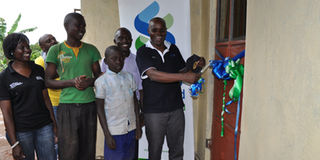I fundraised to build a home for orphans

L-R, Cynthia Mpanga, Livingstone Ssempebwa, Francis Ssekatawa, Brian Mutebi and Herman Kasekende, the Standard Chartered Bank CEO, during the opening ceremony of the house.
What you need to know:
I would travel 160km to supervise the construction process
Journalist worked tirelessly to ensure that Francis Ssekatawa, 14, and Livingstone Ssempebwa, 17, have a proper roof over their heads.
The thought of building a house is soothing. What comes to mind are images of living in your own decent house where you do not have to pay rent.
You can plan and design your compound, do every interior detail you have since admired, many of which you may never do while in a rented house. These are the exact dreams I had. Not for myself but for two orphaned boys. Not even through my charity, Education and Development Opportunity – Uganda (EDOU) did I imagine doing so.
EDOU manages the Brian Mutebi Dream Scholarship Fund through which I give scholarships to children in schools – children who would otherwise have no hope of attaining an education.
But one day while visiting scholarship beneficiaries in Kikooba village, Bukomero Sub-County in Kiboga District, I met two orphaned boys, Francis Ssekatawa, 14, and Livingstone Ssempebwa, 17, whose makeshift structure was almost collapsing on them.
In my imagination, there was nothing I could do to help the situation.
Besides, I was already struggling to raise funds for the charity’s scholarship programme even after selling my piece of land at Kitubulu in Entebbe and putting the money in the Scholarship Fund.
USING MEDIA
I shared the boys’ story with a friend who talked to NTV. In late April, NTV ran the boys on Life Stories programme. An editor at Daily Monitor watched the programme. On July 1, 2014, the newspaper ran a story titled, Children seek help to build collapsing shelter.
Mr Herman Kasekende, the Standard Chartered Bank CEO read the story. He asked bank staff to take up building of a house for these orphans as part of their Employee volunteering initiative.
HOUSE PLAN AND BUYING MATERIAL
I was asked to present a budget and architectural design. I consulted competent local builders who made the drawings. The house was to have a sitting room, two bed rooms with a corridor separating them, a bathroom at the extreme end, a shade in front and a paved veranda.
It would be roofed with iron sheets, cemented floor, paint coated on the inside walls and rough cast on the outside, and a pit latrine outside. It would have one metallic door (front) and wooden doors inside and at the back.
I had to find the price and where building materials would be sourced.
It required nine trips of river sand costing Shs630,000, three trips of lake sand and Shs240,000, seven trips of bricks at Shs840,000, two trips of fine stones at Shs180,000, 50 bags of cement for Shs1.4m, 35 iron sheets for Shs595,000; windows for Shs270,000, doors for Shs800, 000; eight iron bars for Shs160,000, timber for Shs933,000; various kinds of nails for Shs212,000; pipes and wires for Shs95, 000; face board for Shs265,000; wheel barrow, spades, pick axe, barrels and hoes for Shs206,000; and Shs2m as labour fees.
Representatives of the bank visited the children and took their pictures and dilapidated house.
On return to Kampala, they shared pictures with the rest of the bank staff who started fundraising; raising nearly Shs6m. The bank management topped up the amount for the Shs10.8m house.
THE CONSTRUCTION PROCESS
We mobilised residents, especially neighbours, to help in storing building equipment and materials. They also helped in cooking for the builders in addition to providing items to use such as jerry cans and spades. Construction started with me laying the first brick.
Some locals were also hired as porters. It took three days to level the house from the foundation. The process would have been faster had it not been for the heavy rains that poured. But once the foundation was set, it was much faster raising the walls. The building got to the window level in one week and the wall plate in two weeks. The children participated in the building. They helped in carrying the bricks and using a bicycle to fetch water. They did that happily knowing in a matter of days; they would have a house to stay in.
I would travel from Kampala to Kikooba and back (about 160km) almost every evening. Some days, I would get back home as late as midnight. On days when I could not travel, I was on the phone calling the builders and suppliers to ensure everything was on course.
It was expensive travelling from Kampala to Kikooba on average, my daily expenditure was Shs30,000 which totalled to morethan Shs500, 000 a month.
Good enough, I got a cheque of Shs500,000 from a friend who had seen the pictures I had posted on Facebook.
MOVING IN
Morethan 30 Standard Chartered Bank staff came at the site to be involved in the final construction activities. There included painting the house and constructing the toilet. I was particularly amazed by the humility of Mr Kasekende, the bank’s CEO.
He and his staff mixed the sand, carried the bricks and wheel barrows of sand, and participated in the construction of the toilet, laying one layer of bricks on another. Together, we painted the house. After painting, the house was mopped clean. A Shs10.8 million house was ready to be occupied.
The moment of cutting the ribbon for Ssekatawa and Ssepembwa to occupy their new two-bed room house was ecstatic. The boys carried a frame that I helped them buy. Inside the frame was a personalised message they wrote for Standard Chartered Bank; one that everyone present could tell was a message from their heart.
“Nze Livingstone Ssempebwa ne muganda wange Francis Ssekatawa tuli basanyufu nnyo kubanga mutuzimbidde enyumba gyetugenda okusooka okusulamu,” read the message in Luganda. In English, the message could read as: “My brother Francis Ssekatawa and I, Livingstone Ssempebwa are so grateful for building for us a house. It is the first house we are going to stay in.” The last part of the message was more telling.
The bank donated beddings, clothes and household items. I will never forget the smile I saw on Ssekatawa’s face when he sat on a very clean bed laid for him by the bank staff. His had always been a pile of rags. It was a moment that demonstrated that the real value of money is changing lives.
Five months of prayer, dedication and charity had transformed the lives of these two boys forever.




